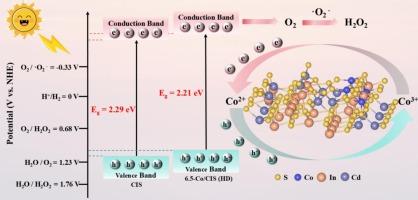Self-regenerative Co2+/Co3+ mediation in Co-doped CdIn2S4 superstructures enables efficient sacrificial-agent-free H2O2 photogeneration
IF 4.7
3区 化学
Q2 CHEMISTRY, PHYSICAL
Journal of Photochemistry and Photobiology A-chemistry
Pub Date : 2025-09-12
DOI:10.1016/j.jphotochem.2025.116772
引用次数: 0
Abstract
Photocatalytic H2O2 production suffers from severe charge recombination and sacrificial agent dependency. Hydrangea-like Co-doped CdIn2S4 superstructures (Co/CIS (HD)) synthesized via hydrothermal method exhibit hierarchical porous architecture that enhances light harvesting and reactant diffusion. Atomic Co doping introduces mixed-valence Co2+/Co3+ species, reducing the work function from 6.287 to 5.896 eV and extending carrier lifetime. The dual-valent system establishes a self-regenerative redox cycle where Co3+ mediates photogenerated electron transfer for O2 activation while Co2+ scavenges holes to suppress recombination and photocorrosion. Without sacrificial agents, the optimized 6.5-Co/CIS (HD) achieves an exceptional H2O2 production rate of 1952 μmol g−1 h−1 under visible light, 6.33 times higher than pristine CdIn2S4. The catalyst maintains structural stability over five cycles due to dynamic Co2+/Co3+ regeneration. This work provides a strategic design for efficient photocatalytic H2O2 synthesis via synergistic morphological and electronic engineering.

自再生Co2+/Co3+介质在共掺杂CdIn2S4上层结构中实现了高效的无牺牲剂H2O2光生成
光催化生产H2O2具有严重的电荷重组和牺牲剂依赖性。通过水热法合成的类绣球状共掺杂CdIn2S4超结构(Co/CIS (HD))具有分层多孔结构,增强了光捕获和反应物扩散。原子Co掺杂引入混合价态Co2+/Co3+,使功函数从6.287 eV降低到5.896 eV,延长了载流子寿命。双价体系建立了一个自再生的氧化还原循环,其中Co3+介导光生电子转移以激活O2,而Co2+清除空穴以抑制重组和光腐蚀。在不添加牺牲剂的情况下,优化后的6.5-Co/CIS (HD)在可见光下H2O2产率达到1952 μmol g−1 h−1,是原始CdIn2S4的6.33倍。由于Co2+/Co3+的动态再生,催化剂在5个循环中保持结构稳定性。这项工作提供了一种通过协同形态和电子工程高效光催化合成H2O2的策略设计。
本文章由计算机程序翻译,如有差异,请以英文原文为准。
求助全文
约1分钟内获得全文
求助全文
来源期刊
CiteScore
7.90
自引率
7.00%
发文量
580
审稿时长
48 days
期刊介绍:
JPPA publishes the results of fundamental studies on all aspects of chemical phenomena induced by interactions between light and molecules/matter of all kinds.
All systems capable of being described at the molecular or integrated multimolecular level are appropriate for the journal. This includes all molecular chemical species as well as biomolecular, supramolecular, polymer and other macromolecular systems, as well as solid state photochemistry. In addition, the journal publishes studies of semiconductor and other photoactive organic and inorganic materials, photocatalysis (organic, inorganic, supramolecular and superconductor).
The scope includes condensed and gas phase photochemistry, as well as synchrotron radiation chemistry. A broad range of processes and techniques in photochemistry are covered such as light induced energy, electron and proton transfer; nonlinear photochemical behavior; mechanistic investigation of photochemical reactions and identification of the products of photochemical reactions; quantum yield determinations and measurements of rate constants for primary and secondary photochemical processes; steady-state and time-resolved emission, ultrafast spectroscopic methods, single molecule spectroscopy, time resolved X-ray diffraction, luminescence microscopy, and scattering spectroscopy applied to photochemistry. Papers in emerging and applied areas such as luminescent sensors, electroluminescence, solar energy conversion, atmospheric photochemistry, environmental remediation, and related photocatalytic chemistry are also welcome.

 求助内容:
求助内容: 应助结果提醒方式:
应助结果提醒方式:


